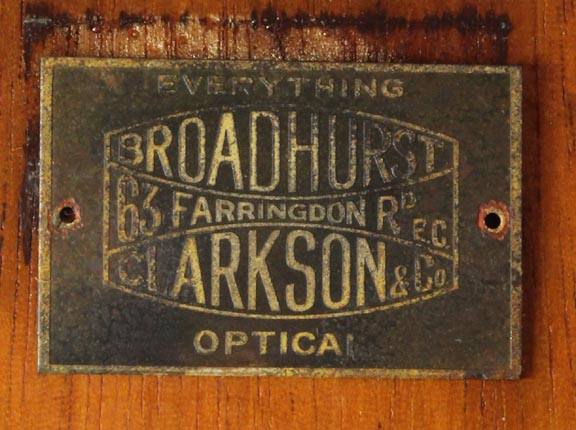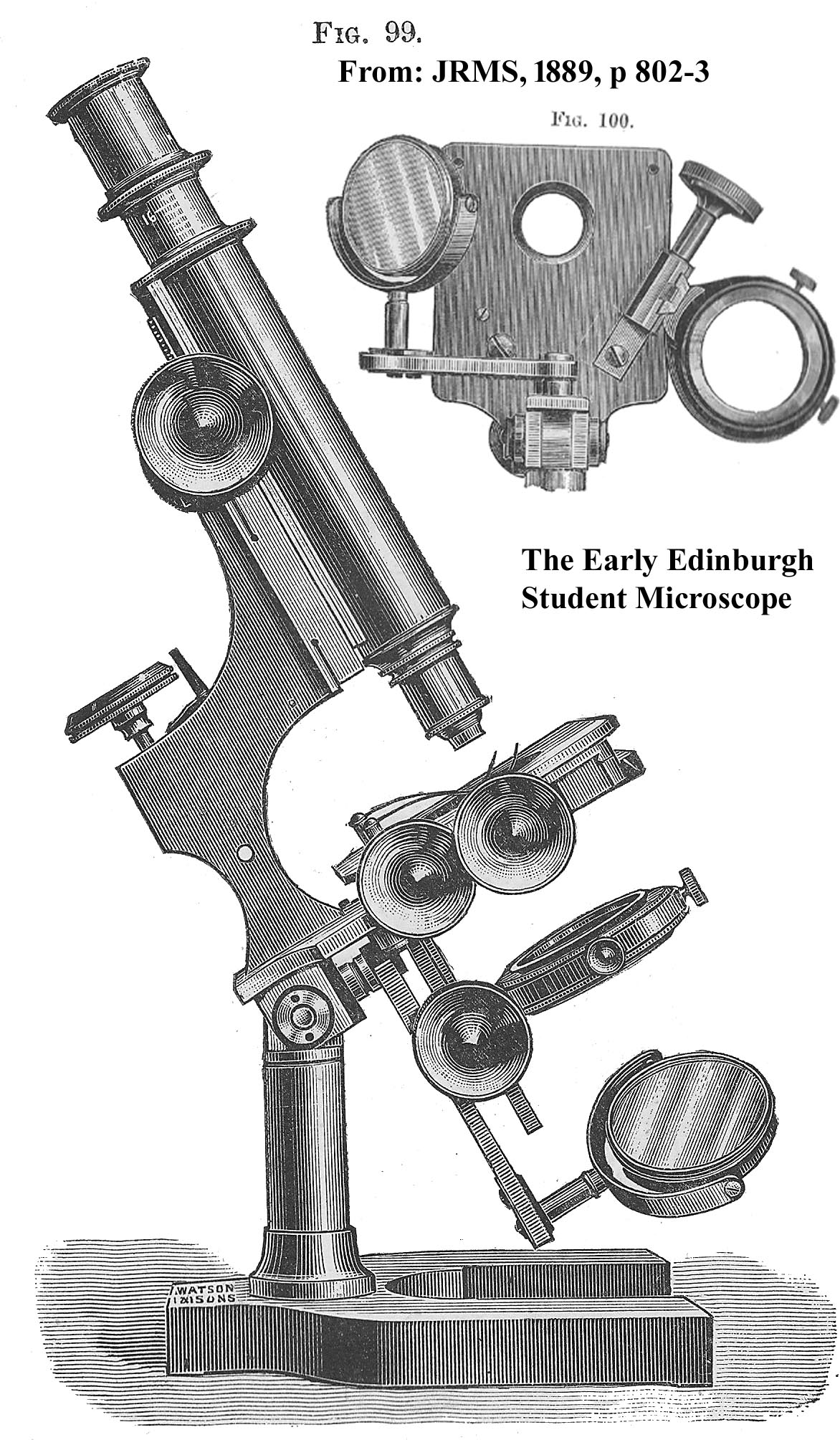ACCESSORIES FOR THE c. 1918 WATSON
EDINBURGH H MICROSCOPE
Accessories currently with this microscope include two
eyepieces and three objectives and a Abbe condenser.
Eyepieces for this microscope and listed in the catalogs of
the time are Huygenian.
Objectives (and matching cans) with this microscope at this
time include:
- Parachromatic 2/3
inch
- Parachromatic 1/6
inch
- Apochromatic 4 mm (1/6
inch)
There is also a can for a parachromatic 1/2
inch, but the objective itself is lacking; I hope to replace it some
day. Watson apochromats were added to the Watson offerings around the
time this instrument was made; Watson
started to make their own apochromatics objectives sometime between
1914 and 1917.
Although there were many condensers to choose from at the
time this microscope was made, it is equipped with the relatively cheap
but standard Abbe condenser.
 The original case has spots for two eyepieces and three objective cans.
There is no other case or drawer for other accessories. The door of the
case has the classic Watson 'W' escutcheon. Inside the front door,
rather than the usual magnification card, is the trade plaque for the
optical retailer, Broadhurst, Clarkson & Co.
The original case has spots for two eyepieces and three objective cans.
There is no other case or drawer for other accessories. The door of the
case has the classic Watson 'W' escutcheon. Inside the front door,
rather than the usual magnification card, is the trade plaque for the
optical retailer, Broadhurst, Clarkson & Co.
Options for this microscope at the time of its manufacture
included fine adjustment to the substage, as the same option for the
Royal model, and an option to increase the horizontal travel of the
stage to 3 inches. The fine adjustment knob could also be ordered with
divisions to hundredths instead of tenths of inches. Like the Royal, Van
Heurck and others, the movements of the stage could be ordered with
vernier calibrations.
HISTORY OF THE
EDINBURGH MODEL MICROSCOPES
The Edinburgh stand, is a model devised in 1887 with the
advice of an Edinburgh professor, Dr Alexander Edington, a lecturer on
bacteriology at the University of Edinburgh.
It preceded the Van Heurck and later Royal models, and indeed
was the inspiration and basic stand on which both were based. The
Edinburgh stand went through several iterations and improvements over
the years. Most of those changes are reflected in this 1918 model, but
a slight change is noted in the 1928 catalog where the substage pinion
box is enlarged compared to this model. Later, another change was to
extend the limb below the stage to support the substage directly; on
that model, as shown in the 36th edition of the Watson catalog, the
condenser assembly independently swings out of the optical axis, like
the Royal and Van Heurck of that era.
 According to Watson's
delivery records, the first example of an Edinburgh microscope was sold
on November 29, 1887. This stand was the
inspiration for the Van Heurck stand, and like the Van Heurck, started
out with a continental foot, but was soon ordered more often
with a tripod
foot. Like the Van Heurck, it was improved progressively over
the
years. This culminated in the Edinburgh 'D' model, shown to the left,
and later the 'H' as shown on this page. These had
most of the basic features of the (later) 'Royal' model. In fact, when
the Royal was first introduced, it was actually slightly smaller than
the Edinburgh H. The various Edinburgh stands were at first indicated
by the numbers 1,2,3, and 4, but by
1890, letters were used A,B,C,D,E,F,G and H. For a
more detailed review of the history of the various Edinburgh models,
please see the Edinburgh 'B' page. This microscope
continued to be manufactured as late as 1945, though by 1938 the
microscope was all black with the controls chrome plated. As can be
seen from the engravings, the original stand had the condenser assembly
attached to a screw under the side of the stage. Later on, as seen on
the 'H' pictured on this page, this attachment became more robust.
According to Watson's
delivery records, the first example of an Edinburgh microscope was sold
on November 29, 1887. This stand was the
inspiration for the Van Heurck stand, and like the Van Heurck, started
out with a continental foot, but was soon ordered more often
with a tripod
foot. Like the Van Heurck, it was improved progressively over
the
years. This culminated in the Edinburgh 'D' model, shown to the left,
and later the 'H' as shown on this page. These had
most of the basic features of the (later) 'Royal' model. In fact, when
the Royal was first introduced, it was actually slightly smaller than
the Edinburgh H. The various Edinburgh stands were at first indicated
by the numbers 1,2,3, and 4, but by
1890, letters were used A,B,C,D,E,F,G and H. For a
more detailed review of the history of the various Edinburgh models,
please see the Edinburgh 'B' page. This microscope
continued to be manufactured as late as 1945, though by 1938 the
microscope was all black with the controls chrome plated. As can be
seen from the engravings, the original stand had the condenser assembly
attached to a screw under the side of the stage. Later on, as seen on
the 'H' pictured on this page, this attachment became more robust.
It is a common misconception that the 'Royal' is generally a
larger stand than the 'Edinburgh H' and this is not true. The tripod
heights, arm/limb size, foot spread and stage are of identical size in
many examples; what makes the 'Royal' appear larger
is the larger diameter optical tube and drawtubes including the rack and pinion draw tube. Even more interesting the substage fine
adjustment was an option even for the Edinburgh H. A rack and pinion drawtube could also be ordered for the Edinburgh. Without the stand actually being engraved with the model name, the final version of the Edinburgh H and the Royal models prior to the 1930s could not be differentiated from one another,
as can be seen by a
side-by-side comparison. Some late Royal models had a wider foot spread-up to 8.5 inches and these then could be differentiated from the Edinburgh H.
 The original case has spots for two eyepieces and three objective cans.
There is no other case or drawer for other accessories. The door of the
case has the classic Watson 'W' escutcheon. Inside the front door,
rather than the usual magnification card, is the trade plaque for the
optical retailer, Broadhurst, Clarkson & Co.
The original case has spots for two eyepieces and three objective cans.
There is no other case or drawer for other accessories. The door of the
case has the classic Watson 'W' escutcheon. Inside the front door,
rather than the usual magnification card, is the trade plaque for the
optical retailer, Broadhurst, Clarkson & Co.  According to Watson's
delivery records, the first example of an Edinburgh microscope was sold
on November 29, 1887. This stand was the
inspiration for the Van Heurck stand, and like the Van Heurck, started
out with a continental foot, but was soon ordered more often
with a tripod
foot. Like the Van Heurck, it was improved progressively over
the
years. This culminated in the Edinburgh 'D' model, shown to the left,
and later the 'H' as shown on this page. These had
most of the basic features of the (later) 'Royal' model. In fact, when
the Royal was first introduced, it was actually slightly smaller than
the Edinburgh H. The various Edinburgh stands were at first indicated
by the numbers 1,2,3, and 4, but by
1890, letters were used A,B,C,D,E,F,G and H. For a
more detailed review of the history of the various Edinburgh models,
please see the Edinburgh 'B' page. This microscope
continued to be manufactured as late as 1945, though by 1938 the
microscope was all black with the controls chrome plated. As can be
seen from the engravings, the original stand had the condenser assembly
attached to a screw under the side of the stage. Later on, as seen on
the 'H' pictured on this page, this attachment became more robust.
According to Watson's
delivery records, the first example of an Edinburgh microscope was sold
on November 29, 1887. This stand was the
inspiration for the Van Heurck stand, and like the Van Heurck, started
out with a continental foot, but was soon ordered more often
with a tripod
foot. Like the Van Heurck, it was improved progressively over
the
years. This culminated in the Edinburgh 'D' model, shown to the left,
and later the 'H' as shown on this page. These had
most of the basic features of the (later) 'Royal' model. In fact, when
the Royal was first introduced, it was actually slightly smaller than
the Edinburgh H. The various Edinburgh stands were at first indicated
by the numbers 1,2,3, and 4, but by
1890, letters were used A,B,C,D,E,F,G and H. For a
more detailed review of the history of the various Edinburgh models,
please see the Edinburgh 'B' page. This microscope
continued to be manufactured as late as 1945, though by 1938 the
microscope was all black with the controls chrome plated. As can be
seen from the engravings, the original stand had the condenser assembly
attached to a screw under the side of the stage. Later on, as seen on
the 'H' pictured on this page, this attachment became more robust.